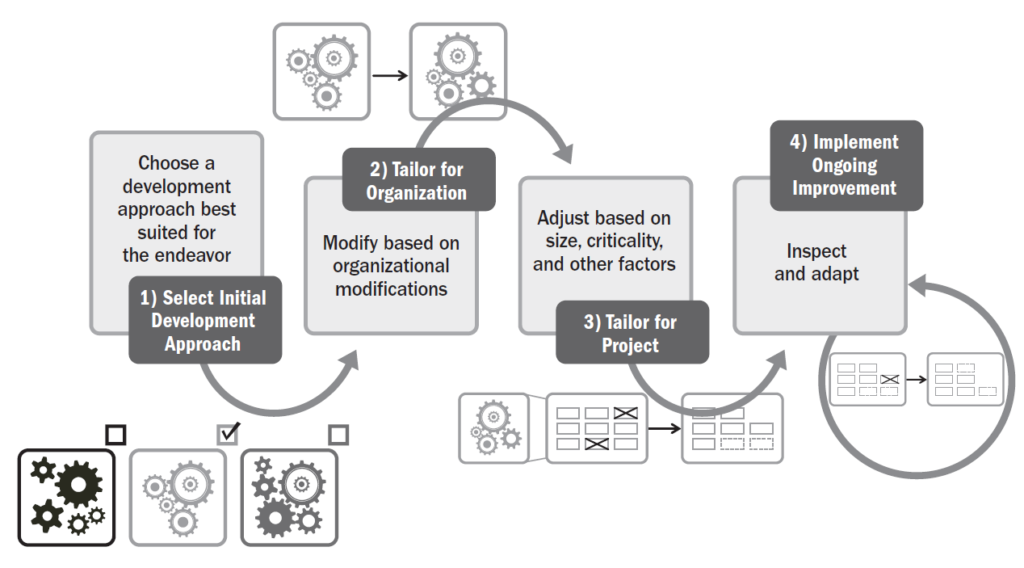Introduction
The seventh edition of the PMBOK® Guide introduces a transformative shift in project management—emphasizing performance domains over prescriptive processes. Among these domains, Project Work stands out as the heartbeat of every project. It encompasses the effort, coordination, and activities required to deliver project outcomes successfully.
However, as every project differs in complexity, industry, and context, applying a one-size-fits-all approach is not only impractical—it can be detrimental. That’s where tailoring becomes vital. Tailoring the Project Work Performance Domain means adapting processes, methods, tools, and governance to suit a project’s unique characteristics and stakeholder needs.
This blog explores what tailoring the Project Work domain entails, why it is crucial, factors that influence tailoring decisions, and practical strategies to tailor project work effectively.
Understanding the Project Work Performance Domain
Project work refers to the integrated effort required to deliver the project outcomes and value. It involves:
- Managing tasks across all life cycle phases (initiating, planning, executing, monitoring, and closing)
- Aligning work with business goals
- Managing changes and project knowledge
- Coordinating across functions
- Addressing risks and dependencies
- Delivering outcomes that satisfy stakeholders
In essence, project work is the “doing” part of project management. But the way we “do” that work can differ dramatically across projects. Tailoring enables project teams to adjust their approach based on internal and external influences while still adhering to the overarching goals of delivering value and maintaining control.
Why Tailoring Project Work Matters
The primary goal of tailoring is to increase effectiveness, efficiency, and stakeholder satisfaction. Here’s why tailoring is essential:
1. Every Project Is Unique
Even projects within the same organization can vary by scope, budget, team, technology, and business drivers. Applying identical templates and processes to dissimilar projects often leads to inefficiencies or misalignment.
2. Boosts Flexibility and Responsiveness
Tailoring allows teams to be more agile—responding quickly to change, minimizing waste, and avoiding over-processing.
3. Optimizes Use of Resources
Over-engineering project work can overwhelm teams and lead to fatigue. Tailoring ensures the effort spent is proportional to the risk, complexity, and importance of the project.
4. Enhances Stakeholder Satisfaction
Customizing how work is executed and communicated ensures that stakeholder needs, expectations, and communication preferences are addressed.
Key Influencing Factors for Tailoring Project Work
Before tailoring project work, it’s essential to assess several factors that can influence how it should be conducted:
1. Project Size and Complexity
- Large, complex projects may need robust documentation, formal governance, and detailed integration plans.
- Smaller projects can benefit from leaner processes and lighter reporting.
2. Organizational Culture and Maturity
- Some organizations are bureaucratic and risk-averse, requiring thorough documentation and strict controls.
- Others may prioritize innovation and agility, valuing flexibility over formality.
3. Regulatory and Compliance Requirements
Projects in highly regulated industries (e.g., pharmaceuticals, finance, aerospace) often have mandatory documentation and audit requirements that influence how work is structured.
4. Stakeholder Requirements
- Some stakeholders prefer frequent check-ins and detailed updates.
- Others are more concerned with the end result and may want to minimize involvement.
5. Development Approach
- Agile projects emphasize collaboration, short feedback cycles, and adaptive planning.
- Predictive (waterfall) projects rely on structured phases, upfront planning, and formal handoffs.
- Hybrid approaches combine the two, and tailoring must address integration across methodologies.
What Aspects of Project Work Can Be Tailored?
Tailoring affects not only the processes used but also the tools, techniques, roles, and governance models. Some elements that can be tailored include:
1. Work Breakdown Structure (WBS)
You can simplify or expand the WBS depending on the complexity and deliverables of the project.
2. Project Schedule and Planning Methods
Choose between detailed Gantt charts, sprint planning, or milestone tracking depending on the team’s needs and delivery approach.
3. Governance and Decision-Making Structures
You can tailor approval hierarchies, meeting frequency, and escalation paths to match the organizational style and project importance.
4. Documentation and Reporting
Tailor the amount and type of documentation required (e.g., full charter, lean canvas, status reports, dashboards).
5. Integration Mechanisms
Decide how various components of the project (technical, business, operations) will be coordinated—whether through formal integration plans or collaborative platforms.
6. Risk Management Approach
Projects with higher uncertainty may need continuous risk analysis and proactive mitigation strategies. Low-risk projects might use a simplified risk log.
Steps to Tailor Project Work Effectively
Tailoring should be deliberate and aligned with project objectives. Here’s a step-by-step approach:
Step 1: Analyze Project Characteristics
Evaluate project complexity, criticality, timeline, team maturity, and stakeholder expectations.
Step 2: Understand Organizational Context
Consider policies, process maturity, tools already in place, and organizational risk tolerance.
Step 3: Decide What to Tailor
Choose which processes, practices, and artifacts will be adopted, adapted, or omitted. Ensure these decisions support value delivery.
Step 4: Document Tailoring Decisions
Include tailoring decisions in the project management plan or charter to ensure transparency and alignment with stakeholders.
Step 5: Review and Adjust as Needed
As the project evolves, reassess your tailoring approach to determine if adjustments are required to stay effective and relevant.
Examples of Tailoring in Different Project Contexts
1. Agile Software Development Project
- Use daily standups and sprints instead of phase-based execution.
- Replace formal status reports with burndown charts and team dashboards.
- Use lightweight documentation and real-time collaboration tools (e.g., Jira, Trello).
2. Infrastructure or Construction Project
- Employ detailed Gantt charts and milestone reviews.
- Use formal documentation and sign-offs for compliance and contractor coordination.
- Establish strict change control boards due to scope impact.
3. Product Launch Campaign (Hybrid)
- Use predictive planning for manufacturing activities.
- Apply agile practices for digital marketing and customer feedback.
- Create integration checkpoints between departments.
Common Pitfalls When Tailoring Project Work
While tailoring provides flexibility, improper application can lead to serious consequences:
1. Lack of Stakeholder Involvement
If tailoring is done in isolation, stakeholder needs may be overlooked, leading to dissatisfaction or rework.
2. Over-Tailoring or Under-Tailoring
- Over-tailoring may strip the project of essential controls and risk mitigation.
- Under-tailoring may result in unnecessary processes that waste time and resources.
3. Ignoring Organizational Standards
Tailoring without considering enterprise-wide frameworks can lead to compliance issues or interoperability challenges.
The Role of the Project Manager in Tailoring
Project managers must lead the tailoring process with a blend of analytical thinking, communication skills, and stakeholder empathy. They should:
- Facilitate discussions with stakeholders to understand needs and constraints.
- Collaborate with team members to assess practicality.
- Stay updated with emerging practices and tools.
- Foster a culture of continuous improvement by reassessing tailoring decisions throughout the project life cycle.
Conclusion
Tailoring the Project Work Performance Domain is a vital component of successful project delivery. By adapting how work is planned, executed, and monitored, project managers can maximize efficiency, reduce risk, and ensure stakeholder alignment. Tailoring isn’t about ignoring best practices—it’s about making them work smarter for the unique context of each project.
In an era where projects span diverse industries, geographies, and technologies, a tailored approach to project work is not only advantageous—it’s essential. Whether you’re working on a high-tech AI implementation or a humanitarian outreach program, tailoring helps you do the right work in the right way for the right reasons.



